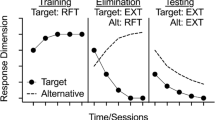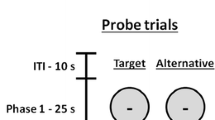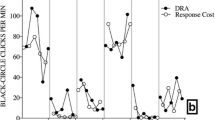Abstract
Resurgence is observed when a previously extinguished behavior reemerges while a more recently reinforced behavior is extinguished. Resurgence is further defined as responding that is greater than an inactive control response that has never produced reinforcement. Recent studies of resurgence using neurotypical adults as participants in human-laboratory investigations have produced discrepant patterns of responding compared to nonhuman animal laboratory studies when comparing control response performance. Namely, human-laboratory investigations have produced no differences between target and control responding, and persistence of all response types across the resurgence-test phase. In the present study, we conducted two human-laboratory experiments to determine if these effects were a product of the history of reinforcement associated with the target response as well as the types of technology used in human-laboratory studies. For all participants, we found no differences in levels of resurgence and occurrence for the target and control response, respectively. Moreover, we observed persistence of all response types across the resurgence-test phase in a manner consistent with prior research. This finding was apparent even when the length of baseline (i.e., reinforcement for the target) was increased, when the length of extinction was increased, and when low-technology stimuli were used. We highlight the implications of this outcome in the context of recent human-laboratory studies that have used arbitrary responses to study resurgence, and discuss the possible role of verbal mediation in these investigations.


Similar content being viewed by others
Data availability
The data that support the findings of this study are available from the corresponding author upon reasonable request.
Change history
25 May 2021
A Correction to this paper has been published: https://doi.org/10.1007/s40732-021-00473-y
References
Baron, A., Kaufman, A., & Stauber, K. A. (1969). Effects of instructions and reinforcement-feedback on human operant behavior maintained by fixed-interval reinforcement. Journal of the Experimental Analysis of Behavior, 12, 701–712. https://doi.org/10.1901/jeab.1969.12-701.
Bolívar, H. A., Cox, D. J., Barlow, M. A., & Dallery, J. (2017). Evaluating resurgence procedures in a human operant laboratory. Behavioural Processes, 140, 150–160. https://doi.org/10.1016/j.beproc.2017.05.004.
Bolívar, H. A., & Dallery, J. (2020). Effects of response cost magnitude on resurgence of human operant behavior. Behavioural Processes, 178, 104187. https://doi.org/10.1016/j.beproc.2020.104187.
Bruzek, J. L., Thompson, R. H., & Peters, L. C. (2009). Resurgence of infant caregiving responses. Journal of the Experimental Analysis of Behavior, 92, 327–343. https://doi.org/10.1901/jeab.2009-92-327.
Bullock, C. E., Fisher, W. W., & Hagopian, L. P. (2017). Description and validation of a computerized behavioral data program: “BDataPro”. The Behavior Analyst, 40(1), 275–285. https://doi.org/10.1007/s40614-016-0079-0.
Cançado, C. R. X., & Lattal, K. A. (2011). Resurgence of temporal patterns of responding. Journal of the Experimental Analysis of Behavior, 95, 271–287. https://doi.org/10.1901/jeab.2011.95-271.
Cox, D. J., Bolívar, H. A., & Barlow, M. A. (2019). Multiple control responses and resurgence of human behavior. Behavioural Processes, 159, 93–99. https://doi.org/10.1016/j.beproc.2018.12.003.
Craig, A. R., & Shahan, T. A. (2016). Behavioral momentum theory fails to account for the effects of reinforcement rate on resurgence. Journal of the Experimental Analysis of Behavior, 105, 375–392. https://doi.org/10.1002/jeab.207.
Craig, A. R., Sullivan, W. E., & Roane, H. S. (2019). Further evaluation of a nonsequential approach to studying operant renewal. Journal of the Experimental Analysis of Behavior, 112, 210–223. https://doi.org/10.1002/jeab.546.
da Silva, S. P. D., Maxwell, M. E., & Lattal, K. A. (2008). Concurrent resurgence and behavioral history. Journal of the Experimental Analysis of Behavior, 90, 313–331. https://doi.org/10.1901/jeab.2008.90-313.
Diaz-Salvat, C. C., St. Peter, C. C., & Shuler, N. J. (2020). Increased number of responses may account for reduced resurgence following serial training. Journal of Applied Behavior Analysis, 53(3), 1542–1558. https://doi.org/10.1002/jaba.686.
Doughty, A. H., Cash, J. D., Finch, E. A., Holloway, C., & Wallington, L. K. (2010). Effects of training history on resurgence in humans. Behavioural Processes, 83, 340–343. https://doi.org/10.1016/j.beproc.2009.12.001.
Doughty, A. H., da Silva, S. P., & Lattal, K. A. (2007). Differential resurgence and response elimination. Behavioural Processes, 75, 115–128. https://doi.org/10.1016/j.beproc.2007.02.025.
Doughty, A. H., & Oken, G. (2008). Extinction-induced response resurgence: A selective review. The Behavior Analyst Today, 9, 27. https://doi.org/10.1037/h0100644.
Epstein, R. (1983). Resurgence of previously reinforced behavior during extinction. Behaviour Analysis Letters, 3, 391–397.
Fisher, W. W., Saini, V., Greer, B. D., Sullivan, W. E., Roane, H. S., Fuhrman, A. M., Craig, A. R., & Kimball, R. T. (2019). Baseline reinforcement rate and resurgence of destructive behavior. Journal of the Experimental Analysis of Behavior, 111, 75–93. https://doi.org/10.1002/jeab.488.
Flesher, M., & Hoffman, H. S. (1962). A progression for generating variable-interval schedules. Journal of the Experimental Analysis of Behavior, 5, 529–530. https://doi.org/10.1901/jeab.1962.5-529.
Fuhrman, A. M., Fisher, W. W., & Greer, B. D. (2016). A preliminary investigation on improving functional communication training by mitigating resurgence of destructive behavior. Journal of Applied Behavior Analysis, 49(4), 884–899. https://doi.org/10.1002/jaba.338.
Ho, T., Bai, J. Y., Keevy, M., & Podlesnik, C. A. (2018). Resurgence when challenging alternative behavior with progressive ratios in children and pigeons. Journal of the Experimental Analysis of Behavior, 110(3), 474–499. https://doi.org/10.1002/jeab.474.
Kestner, K. M., & Peterson, S. M. (2017). A review of resurgence literature with human participants. Behavior Analysis: Research and Practice, 17, 1–17. https://doi.org/10.1037/bar0000039.
Kuroda, T., Cançado, C. R., & Podlesnik, C. A. (2016). Resistance to change and resurgence in humans engaging in a computer task. Behavioural Processes, 125, 1–5. https://doi.org/10.1016/j.beproc.2016.01.010.
Lambert, J. M., Bloom, S. E., Samaha, A. L., Dayton, E., & Rodewald, A. M. (2015). Serial alternative response training as intervention for target response resurgence. Journal of Applied Behavior Analysis, 48, 765–780. https://doi.org/10.1002/jaba.253.
Lattal, K. A., Cançado, C. R., Cook, J. E., Kincaid, S. L., Nighbor, T. D., & Oliver, A. C. (2017). On defining resurgence. Behavioural Processes, 141, 85–91. https://doi.org/10.1016/j.beproc.2017.04.018.
Lattal, K. A., & Oliver, A. C. (2020). The control response in assessing resurgence: Useful or compromised tool? Journal of the Experimental Analysis of Behavior, 113, 77–86. https://doi.org/10.1002/jeab.570.
Lattal, K. A., & St. Peter Pipkin, C. (2009). Resurgence of previously reinforced responding: Research and application. The Behavior Analyst Today, 10, 254–266. https://doi.org/10.1037/h0100669.
Lattal, K. A., Solley, E. A., Cançado, C. R., & Oliver, A. C. (2019). Hierarchical resurgence. Journal of the Experimental Analysis of Behavior, 112(2), 177–191. https://doi.org/10.1002/jeab.547.
Leitenberg, H., Rawson, R. A., & Bath, K. (1970). Reinforcement of competing behavior during extinction. Science, 169, 301–303.
Mackintosh, I. (1955). Irrelevant responses during extinction. Canadian Journal of Psychology, 9, 183–189. https://doi.org/10.1037/h0083638.
Madden, G. J., Chase, P. N., & Joyce, J. H. (1998). Making sense of sensitivity in the human operant literature. The Behavior Analyst, 21, 1–12. https://doi.org/10.1007/BF03392775.
Marsteller, T. M., & St. Peter, C. C. (2012). Resurgence during treatment challenges. Mexican Journal of Behavior Analysis, 38, 7–23.
Nevin, J. A., Mace, F. C., DeLeon, I. G., Shahan, T. A., Shamlian, K. D., Lit, K., Sheehan, T., Frank-Crawford, M. A., Trauschke, S. L., Sweeney, M. M., Tarver, D. R., & Craig, A. R. (2016). Effects of signaled and unsignaled alternative reinforcement on persistence and relapse in children and pigeons. Journal of the Experimental Analysis of Behavior, 106, 34–57. https://doi.org/10.1002/jeab.213.
Podlesnik, C. A., Jimenez-Gomez, C., & Shahan, T. A. (2006). Resurgence of alcohol seeking produced by discontinuing non-drug reinforcement as an animal model of drug relapse. Behavioural Pharmacology, 17, 369–374. https://doi.org/10.1097/01.fbp.0000224385.09486.ba.
Podlesnik, C. A., & Kelley, M. E. (2015). Translational research on the relapse of operant behavior. Mexican Journal of Behavior Analysis, 41, 226–251.
Podlesnik, C. A., & Shahan, T. A. (2009). Behavioral momentum and relapse of extinguished operant responding. Learning & Behavior, 37, 357–364. https://doi.org/10.3758/LB.37.4.357.
Podlesnik, C. A., & Shahan, T. A. (2010). Extinction, relapse, and behavioral momentum. Behavioural Processes, 84, 400–411. https://doi.org/10.1016/j.beproc.2010.02.001.
Pritchard, D., Hoerger, M., & Mace, F. C. (2014). Treatment relapse and behavioral momentum theory. Journal of Applied Behavior Analysis, 47, 814–833. https://doi.org/10.1002/jaba.163.
Reed, P., & Morgan, T. A. (2006). Resurgence of response sequences during extinction in rats shows a primacy effect. Journal of the Experimental Analysis of Behavior, 86, 307–315. https://doi.org/10.1901/jeab.2006.20-05.
Saini, V., & Roane, H. S. (2018). Technological advances in the experimental analysis of human behavior. Behavior Analysis: Research & Practice, 18, 288–304. https://doi.org/10.1037/bar0000124.
Schwartz, B. (1980). Development of complex, stereotyped behavior in pigeons. Journal of the Experimental Analysis of Behavior, 33, 153–166. https://doi.org/10.1901/jeab.1980.33-153.
Sullivan, W. E., Saini, V., DeRosa, N. M., Craig, A. R., Ringdahl, J. E., & Roane, H. S. (2020). Measurement of nontargeted problem behavior during investigations of resurgence. Journal of Applied Behavior Analysis, 53, 249–264. https://doi.org/10.1002/jaba.589.
Sweeney, M. M., & Shahan, T. A. (2015). Renewal, resurgence, and alternative reinforcement context. Behavioural Processes, 116, 43–49. https://doi.org/10.1016/j.beproc.2015.04.015.
Sweeney, M. M., & Shahan, T. A. (2016). Resurgence of target responding does not exceed increases in inactive responding in a forced-choice alternative reinforcement procedure in humans. Behavioural Processes, 124, 80–92. https://doi.org/10.1016/j.beproc.2015.12.007.
Trask, S., Schepers, S. T., & Bouton, M. E. (2015). Context change explains resurgence after the extinction of operant behavior. Mexican Journal of Behavior Analysis, 41(2), 187–210.
Volkert, V. M., Lerman, D. C., Call, N. A., & Trosclair-Lasserre, N. (2009). An evaluation of resurgence during treatment with functional communication training. Journal of Applied Behavior Analysis, 42, 145–160. https://doi.org/10.1901/jaba.2009.42-145.
Wathen, S. N., & Podlesnik, C. A. (2018). Laboratory models of treatment relapse and mitigation techniques. Behavior Analysis: Research & Practice, 18(4), 362–387. https://doi.org/10.1037/bar0000119.
Winterbauer, N. E., Lucke, S., & Bouton, M. E. (2013). Some factors modulating the strength of resurgence after extinction of an instrumental behavior. Learning and Motivation, 44, 60–71. https://doi.org/10.1016/j.lmot.2012.03.003.
Author information
Authors and Affiliations
Corresponding author
Ethics declarations
Conflict of Interest
On behalf of all authors, the corresponding author states that there is no conflict of interest.
Informed Consent
All procedures performed involving human participants were in accordance with the ethical standards of the institutional research committee and with the 1964 Helsinki Declaration and its later amendments. This study was reviewed and received clearance from the SUNY Upstate Medical University Institutional Review Board [#960296-2 and #1641106-1]. Informed consent and publication of findings was provided in writing by participants. The authors have no conflict of interest to declare.
Additional information
Publisher’s Note
Springer Nature remains neutral with regard to jurisdictional claims in published maps and institutional affiliations.
The original online version of this article was revised: The last names of 2 co-authors are misspelled and should be corrected as follows:
"Kate Derrenback" should be "Kate Derrenbacker".
"Arohan Rima" should be "Arohan Rimal".
Rights and permissions
About this article
Cite this article
Saini, V., Sullivan, W.E., Craig, A.R. et al. Responding Fails to Extinguish During Human-Laboratory Experiments of Resurgence. Psychol Rec 71, 325–336 (2021). https://doi.org/10.1007/s40732-021-00469-8
Accepted:
Published:
Issue Date:
DOI: https://doi.org/10.1007/s40732-021-00469-8




